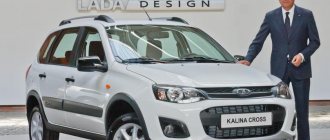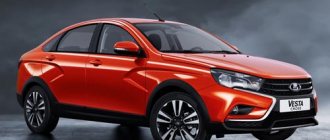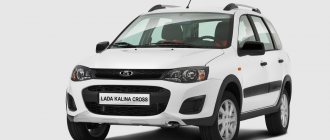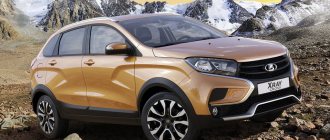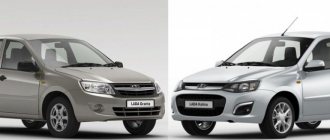Lada XRAY caused controversial reviews from the very beginning. What kind of car is this: a hatchback or a city crossover? Is it Russian or a converted foreign car? One thing is clear that he immediately aroused interest in himself.
XRAY turned out to be a completely new car that has nothing to do with Vesta; it is based on the Renault platform.
In its design, XRAY carries the concept of X-design from Steve Mattin: due to the embossed deep X-shaped stampings, the wings visually look larger.
Test Drive
Before XRAY, AvtoVAZ did not make crossovers. We can safely say that the XRAY is a compact urban crossover with front-wheel drive. The car turned out to be tightly built, with a high hood and a massive rear end.
Even the basic version of the model comes with 16-inch wheels. The high ground clearance of 195 mm only emphasizes the seriousness of the model.
So outwardly the car does not leave the impression of being small. The dynamics of the exterior are added by new head optics and LED running lights.
Verdict
“Cross” is not just an attempt to make a semblance of an SUV out of a regular hatchback. For AvtoVAZ, this is also “working on mistakes”, in which they tried to take into account the feedback and wishes of the owners of Xray. True, most of these improvements will remain “exclusive” to the Cross version and will not appear on the regular Xray.
The editors recommend:
Quiz!
Blackvue DVR for knowledge of traffic rules Alternative to a scraper: how to clean car windows without scratching them
Better than Kruzak: Toyota presented a huge frame SUV
3 million is not a luxury: transport tax in Russia will be calculated in a new way
Which cars do dealers make the biggest markups on: list
Discussion Cancel
Main characteristics of the car:
| Body | |||
| Wheel formula / drive wheels | 4 x 2 / front | ||
| Engine location | anterior transverse | ||
| Body type / number of doors | hatchback / 5 | ||
| Length / width / height, mm | 4165 / 1764 / 1570 | ||
| Base, mm | 2592 | ||
| Front/rear wheel track, mm | 1484…1492 / 1524…1532 | ||
| Ground clearance, mm | 195 | ||
| Luggage compartment volume in passenger/cargo versions, l | 361/1207 | ||
[ads1]
Interior
The interior of the XRAY can be called laconic rather than budget-friendly. It is not overloaded with buttons and unnecessary elements. Even the seat heating buttons are in the blind spot and do not interfere with the eye.
You also don’t need buttons to control the media system – there is a touch screen. However, under the thumb of the right hand on the steering wheel there is a block of keys. The steering wheel is also perfectly adjustable in height, and a comfortable grip is designed for the fingers. There is no adjustment for reach, but you can adjust the driver's seat so that it is comfortable to sit.
The numbers on the dashboard are easy to read, and there is an on-board computer with a lot of necessary gadgets, including the outside temperature. The storage problem is also well resolved in the cabin - there is a drawer under the front seat, spacious pockets on the doors, and cup holders are provided on the console in the center.
There are no complaints about the assembly of the interior: the gaps are even, the structural elements do not move, there is no rattling. The finish is quite decent to the touch and visually.
The profile of the seats, as always, is not the best: the seats are flat, the cushion is short, and there is no lumbar support. Your back will get tired on long trips. A family of four can comfortably fit inside the cabin. In the rear seats, thanks to the slightly reclined seat backs, two adults and, even more so, children will be moderately comfortable. However, the third one there will be clearly superfluous.
Body
The body design of the Lada X-Ray pleases the eye with its novelty and attracts attention with the unexpected VAZ emblem, but the embossed sides of the car, effectively profiled using the X-design, suggest problems in restoring the edges if damaged
The steel of the body elements is of high quality - it does not bend when pressed by hand, but there are complaints about the assembly - upon careful examination, the difference in the size of the gaps is noticeable.
The trunk, although small by crossover standards, is spacious enough to fit a baby stroller and a couple more medium-sized travel bags. The trunk lid opens by pressing an electric drive button protected by a rubber sheath. There is a 12 V socket in the luggage compartment on the left, making it easy to use a car compressor to inflate tires. But the raised floor, the purpose of which is uncertain, is fragile and is pressed under load, so transportation of a significant weight of cargo must be carried out without it, and it is not clear where to temporarily place it along the way.
The ground clearance of 195 mm in combination with short overhangs suits the purpose of the car, but the reason for the lack of roof rails is unknown.
Also disappointing is the access to the unlocked compartment lid with the fuel tank neck that is not controlled by the driver.
Trunk
To increase trunk volume, the car was even slightly lengthened. The trunk volume is not that small. In the top configuration, it is equipped with a convenient double bottom, under which you can easily hide the tool. Larger tools such as a jack can be stored in the lockable side niches.
The compartment geometry is flat, without protruding wheel arches. Hooks, lighting, and brackets for nets are carefully located around the perimeter. There's even an outlet. The ease of loading is also flawless: the threshold is low and the bumper protrudes slightly.
The problem of opening the trunk is conveniently implemented compared to previous models. The rubberized release button is located in the license plate niche and is on the folding key.
If you fold the backs of the rear seats, you get a more/less flat floor and quite a large volume, and if you roll the front seats as far forward as possible, then a short driver can even pass the night quite comfortably.
CHASSIS
The front has an independent suspension with MacPherson struts, unified with the Renault Duster. Judging by the Duster, it’s reliable and inexpensive. At the rear there is a regular “beam” with springs and shock absorbers. In terms of driving performance, it is of medium hardness: it smooths out minor road irregularities and does not break through the struts in large potholes.
— It’s a bit harsh on 17-inch wheels. But it handles well. For comfort, “sixteenth” or even “fifteenth” with large tires is better. In the rear seats, passengers complain about excessive shaking on bumps, notes Evgeniy.
The ground clearance is 19.5 cm. This is enough for comfortable parking to the curb, and on winter ruts - without clinging to the bottom.
However, you can’t rely only on ground clearance - due to the lack of all-wheel drive and at least some off-road qualities, you can only drive off the asphalt if you are convinced that the ground is hard.
Power characteristics
| 1.8 l 16-cl., 5AMT, 122 hp | 1.6 l 16-cl., 5MT, 106 hp | 1.6 l 16-cl., 5MT, 110 hp | |
| Engine | |||
| engine's type | petrol | ||
| Supply system | electronically controlled fuel injection | ||
| Number, arrangement of cylinders | 4, in-line | ||
| Working volume, cubic meters cm | 1800 | 1596 | 1598 |
| Maximum power, hp / kW / rev. min. | 122 / 90 / 6000 | 106 / 78 / 5800 | 110 / 81 / 5500 |
| Maximum torque, Nm / rev. min. | 173 / 3500 | 148 / 4200 | 150 / 4000 |
| Fuel | gasoline with an octane rating of at least 95 | ||
| Dynamic characteristics | |||
| Maximum speed, km/h | 183 | 170 | 171 |
| Acceleration time 0-100 km/h, s | 10,9 | 11,9 | 10,3 |
| Fuel consumption | |||
| Combined cycle, l/100 km | 7,1 | 7,5 | 6,9 |
The driver can choose a model with one of three engines. The most optimal is a gasoline engine with 110 horsepower. These are its passport characteristics when working with recommended 92 gasoline.
If gasoline is replaced with 95, then the engine is capable of producing 114 horses. This engine is paired with a 5-speed manual transmission from Renault. The car is controlled easily and smoothly. Electric power steering reduces strain on your hands.
The engine is high-torque, elastic, and pulls the car up to operating speeds without problems, even in 5th gear from idle. Acceleration dynamics are also at the level - 10.3 seconds to hundreds on 15-16 wheels.
On seventeenth wheels, acceleration will take about 11.2 seconds. Some complaints appear at high speeds, more than 120 km/h. The gears of the manual are quite short, and when the speedometer needle reaches a hundred, the tachometer pointer approaches 3,000 rpm. At highway speeds this can result in increased fuel consumption and roaring noise.
The X-ray passes through a broken section of the road absolutely calmly, without transmitting vibrations to either the steering wheel or the interior. Reactions to the steering wheel are clear and predictable. The roll is moderate, the behavior is front-wheel drive with a slight tendency for the front axle to drift when turning when overspeeding and a strict stabilization system.
The second engine is 1.8 liters. with a capacity of 122 horses. It is equipped with an automated AMT gearbox. In any rpm range, when you engage a gear and press the gas, you definitely feel a pickup. In automatic mode the car runs smoother. Gear changes are noticeable even during automatic driving, but still the car selects the most optimal options. The engine noise insulation is excellent.
AvtoVAZ is not going to install an automatic transmission; nevertheless, in this case the price of the car will rise significantly. But the driver will have to get used to the operation of AMT. This box is identical in design to the one found on Vesta and, according to the manufacturer, is trained to get used to the owner’s specific driving style, adjusting its operating algorithm to suit it.
The robot starts smooth, leisurely acceleration without problems, but in city traffic jams or during active driving, the box may begin to twitch when switching. When driving on slopes, it is better to work in manual mode. By the way, unlike Vesta, in manual mode the reduced mode is activated by moving away from you.
You can opt for the VAZ engine with 106 horsepower and a volume of 1.6 liters.
[ads2]
In the snow near Moscow...
The presence of only front-wheel drive in all subjects, of course, greatly reduces their cross-country ability. Moreover, the ground clearance of all cars lies in a very modest range - 175–195 mm. The most modest is the Donfeng hatchback, the maximum is the single-platform Renault and Lada, and in the middle (185 mm) is the Lifan. In addition, all crossovers had rather long front overhangs; the H30 was especially distinguished by its “beak”. ESP is missing only on Donfeng; on the X50 it can be disabled, but on the other two, on the contrary, it cannot be deactivated. But we still tried to get through them on virgin soil with heavy, wet snow. Perhaps these conditions look harmless in photos and videos, but in reality this is not easy for front-wheel drive: cars simply pile up a bunch of snow under the bottom and “hang” on the “face”. It seems that clearance decides? But, oddly enough, the car with the lowest ground clearance, Dongfeng, won this test. It was he who managed to get further than the others, although he was also the only one who had to be pushed out later. Lifan clearly takes care of the variator and does not allow the engine to spin properly even with ESP turned off, so it was not able to “catch up” with the H30. In addition, Lifan has the “weakest” tires: Amtel NordMaster 2. They seemed even less successful than those installed on Dongfeng Nordman 4. Well, the worst performers were the “brothers” on Michelin X-Ice - Lada and Renault, which, if possible, disabling stabilization systems would most likely be among the leaders.
Other Features
Visibility in the car is excellent, helped by the huge side mirrors. Additional functions will not interfere with visibility - an electrically heated windshield, frameless windshield wipers, and even a wide-angle color rear view camera.
Onboard navigation pleasantly surprises with its speed, ease of control and detailed depiction of the landscape. Maps can be updated periodically. There is a button to turn off ESC on the center console. To deactivate the electronic assistant, you need to hold the button for about two seconds. With ESC disabled, it is more convenient to operate in off-road conditions (for example, in slushy snow on an uphill slope).
Exterior
The striking design of the Hray with X-shaped relief stampings, the original slope of the windshield and the curve of the roof looks sporty and modern.
The exterior also features the following elements:
- Head optics. The narrowed headlights feature integrated LED running lights.
- Radiator grille. The massive radiator grille, made in the signature X-style, gives the car a brutal look.
- Protective body kits. Practical protective body kits and embossed fenders emphasize the off-road character of the car.
- The back of the car. The laconic rear of the car is decorated with neat headlights and a large bumper.
Options
| Equipment | Price | Engine | checkpoint |
| 1.6 Optima MT | 599 900 ₽ | petrol 1.6, 106 hp | Mechanical 5 |
| 1.6 Optima Advanced MT | 660 900 ₽ | petrol 1.6, 106 hp | Mechanical 5 |
| 1.8 Optima Advanced MT | 685 900 ₽ | petrol 1.8, 122 hp | Mechanical 5 |
| 1.6 Luxe MT | 710 900 ₽ | petrol 1.6, 106 hp | Mechanical 5 |
| 1.8 Optima Advanced AMT | 710 900 ₽ | petrol 1.8, 122 hp | Automatic 5 |
| 1.8 Luxe MT | 735 900 ₽ | petrol 1.8, 122 hp | Mechanical 5 |
| 1.6 Luxe Prestige MT | 739 900 ₽ | petrol 1.6, 106 hp | Mechanical 5 |
| 1.8 Luxe AMT | 760 900 ₽ | petrol 1.8, 122 hp | Automatic 5 |
| 1.8 Luxe Prestige MT | 773 900 ₽ | petrol 1.8, 122 hp | Mechanical 5 |
| 1.8 Luxe Prestige AMT | 798 900 ₽ | petrol 1.8, 122 hp | Automatic 5 |
| 1.8 Exclusive MT | 805 900 ₽ | petrol 1.8, 122 hp | Mechanical 5 |
| 1.8 Exclusive AMT | 830 900 ₽ | petrol 1.8, 122 hp | Automatic 5 |
Even in the basic version, the car is quite well equipped. The Optima configuration comes with a 106-horsepower engine with manual transmission. The Optima has 16-inch alloy wheels, stability control, and driver and passenger airbags.
The 2 rear seats have comfortable headrests. It is equipped with a security alarm, an immobilizer, engine and hood protection, an on-board computer, ERA-Glonass and a radio tape recorder. If you additionally purchase the Comfort package, the car owner will become the proud owner of air conditioning and heated front seats.
The Top package can be distinguished by the presence of foglights, electric rear door windows, electrically heated rear-view mirrors, a multimedia system with a seven-inch display and parking sensors. The optional Prestige package includes climate control, rain and light sensors and a rear view camera. For the premium package there is 75% tinting of the rear windows.
All configurations are available in versions with a 1.8 engine and with an AMT robot.
Brake system
On the Lada XRay, depending on the configuration, wheels are installed on R-15 or R-16 rims. Regardless of the size of the wheels, the brakes are disc in front and drum in the rear, the efficiency of which is much lower.
The list of shortcomings will probably be added to by car enthusiasts over time. Some of them will be taken into account by the manufacturer and eliminated, while others will be considered consistent with the declared class of the car. However, we can say with confidence that the list of advantages of this car is many times greater than the number of disadvantages, and after improvement it will become an even more desirable acquisition for a wide range of car enthusiasts.
